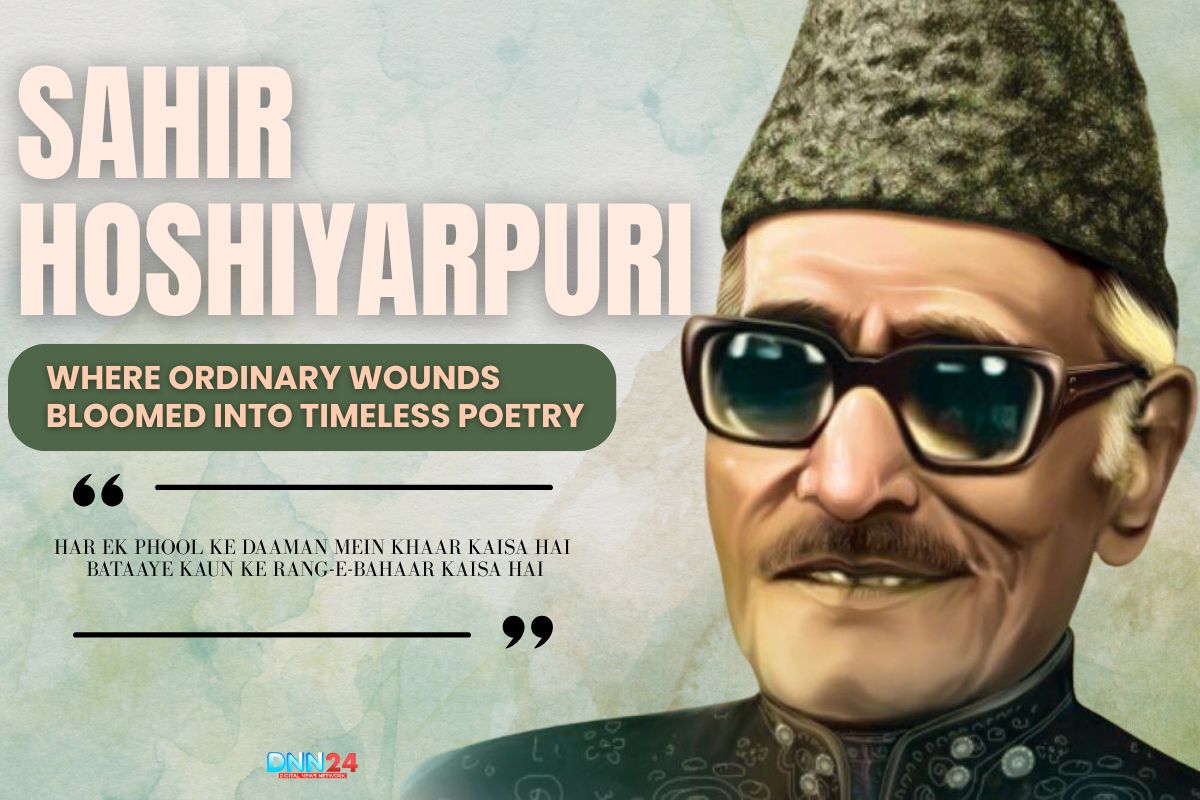Sahir Hoshiyarpuri, a name that floats with the fragrance of old Urdu books and the earthy aroma of Punjab’s rain-soaked soil, did not step into the world as ‘Sahir’. Ram Prakash was born on February 10, 1913, in a small Indian town named Hoshiarpur, Punjab. As a child, the kind Ram dwelt in two worlds: the busy world of real life and the world of dreams, poetry, and impossible hopes.
kaun kahta hai mohabbat ki zaban hoti hai
Sahir Hoshiyarpuri
ye haqiqat to nigahon se bayan hoti hai
The cultural atmosphere of Lahore moulded his young soul, and he studied higher education in Persian and shortly entered into his family business. Business never domesticated the poet in him. The secluded, seldom-visited corners of his father’s shop were his secret world. It is there that little Ram wrote his first verses on brown paper wrappings, and kept them secret to the world, writing pain into rhyme, and hope into meter. This is the story that is seldom heard of, and it was the beginning of the silent journey of Sahir- a journey that took him out of Ram to the Sahir who was the wizard of words.
gham-e-dil ruKH se ayan ho ye zaruri to nahin
Sahir Hoshiyarpuri
ishq ruswa-e-jahan ho ye zaruri to nahin
Brotherhood, Mentors, and What Friendship Means
Any great poet has a story of relationships behind him–stormy and soothing. Although most of us can recall the verses by Sahir, not many are aware of the friendship he had with Mehr Lal Soni Zia Fatehabadi. Their connection began in the canteens of Lahore and blossomed in the narrow lanes of Kanpur, where they together edited the journal ‘Chandan’. Night-time debates over poetry, guffaws reverberating in hostel corridors and the trauma of partition- these scenes made them bond together like blood.
ishq kya chiz hai ye puchhiye parwane se
Sahir Hoshiyarpuri
zindagi jis ko mayassar hui jal jaane se
But maybe the sweetest one was his mentor: Josh Malsiani. It is Josh who straightened the trembling hands of Sahir when he was struggling with difficult meters. The quavering affirmation, the muted suffering, in the background of every Sahir ghazal, is the echo of Josh with his soft corrections. This unknown, yet essential brotherhood not only informed the poetic identity of Sahir but also made him stand on the ground of humility, even as his words were applauded in mushairas.
mere marne ki bhi un ko na KHabar di jae
Sahir Hoshiyarpuri
kis liye apnon ko taklif-e-safar di jae
Ghazal, Nazm and the Whispered Tales Inside
We do not even think twice when we say, Kaun kehta hai mohabbat ki zubaan hoti hai, yeh haqeeqat toh nigahon se bayaan hoti hai and yet we do not think of whose heartbreak is in these lines. During the 1950s, one of the close friends of Sahir came back home after the war, and his wounds were beyond repair. The friend, with trembling lips, told his mute love and how his eyes had told of years of silent worship. Sahir did not sleep that night; the words rained in his heart. And by the first light of dawn, that friend had turned his grief into poetry–a couplet which will last forever.
bas farq is qadar hai gunah o sawab mein
Sahir Hoshiyarpuri
piri mein wo rawa hai ye jaez shabab mein
So many of Sahir’s ghazals and nazms are not mere exercises in literature, but notes of life, living notes of the common people of India, the courageous seller, the sorrowful mother, the lonely lover. A poem written in honor of the lost laughter of his childhood friend; a nazm written in honor of the strength of a woman widowed on partition- these are not just rumors but the true spirit of Sahir writing. Even his Mahavir Mahima musaddas, written on the life of Mahavir, was based on listening to the stories of Jain monks in the bylanes of Faridabad, and making spiritual truth musical and melodious in Urdu.
aap se kya dosti hone lagi
Sahir Hoshiyarpuri
apne dil se dushmani hone lagi
Sahir Hoshiyarpuri: The Untold Night of Mushaira
Not all victories are shared. There is a story that is only uttered during family meetings that talk of the greatest mushaira night of Sahir. In Delhi, where he was an unknown young man only known in literary circles, Sahir spent the whole evening preparing to read his latest ghazal. However, backstage, his palms were getting clammy, and the fine paper with his poems fell out of his kurta. He panicked and wrote the ghazal out of memory, but it came to him with new lines. The ghazal that the audience listened to that night was not his originally intended one, but an improvisation.
zindagi hum se KHafa ho jaise
Sahir Hoshiyarpuri
ab dawa ho na dua ho jaise
Thundered out on the dais, Aakhir tadap-tadap ke yeh khamosh ho gaya, dil ko sukoon mil hi gaya iztirab mein… and the crowd went wild. What they never knew is that the now-famous verse was a creation of misplaced notes and the unconquered spirit of Sahir. Applause that night was not only on poetry, but on courage, on surviving one moment of loss and making it beautiful.
wo mere dil ke talabgar nazar aate hain
Sahir Hoshiyarpuri
shadmani ke ab aasar nazar aate hain
Sahir Hoshiyarpuri: The Panchatantra, Mahavir and the Secret Philosophies
All people love the poet, but not many people know Sahir the translator and spiritual seeker. During his later years of quiet life, when he was out of the limelight, Sahir devoted himself to translating the ancient stories of the Panchatantra into English and used to write fables to his adorable child, Malti. In his opinion, wisdom locked in a single language is famished to the world. His musaddas on Mahavir is a singular literary endeavour to marry religion and poetry–a Hindu poet who makes the Jain philosophy palatable, and available to the world in supple Urdu, not merely touching the heart but the soul.
KHwab dekhe the suhane kitne
Sahir Hoshiyarpuri
jag uThe dard purane kitne
These poems, which are rarely lauded, show a Sahir who was more than a man of pain; he wanted to heal and bridge across religious and time boundaries. A family friend told one story: Sahir went to a Jain lecture and sat in silence for hours afterward, then his pen moved involuntarily, as though possessed, creating in a kind of trance the song, Mahavir Mahima.
gham ka sahra na mila dard ka dariya na mila
Sahir Hoshiyarpuri
hum ne marna bhi jo chaha to wasila na mila
Sahir Hoshiyarpuri: Legacy, Lessons and the Inspiration That Remains
If there is one lesson Sahir Hoshiyarpuri’s life whispers, it is that real poetry grows from wounds and wonder. His poems were familiar to start with the sadness he felt in the failure of family business, his religious doubts, the death of friends, and the flaming heart of post-partition India. However, these pains were not bitterness at all, but they caused lines that had consoled and moved others. Legends go about Jagjit Singh, the legendary ghazal singer, who was comforted by the simple but lyrical poetry of Sahir and took the lines to millions of people.
wo jis ko hum ne apnaya bahut hai
Sahir Hoshiyarpuri
usi ne dil ko taDpaya bahut hai
Ghalib Award, acclaim in the literary circles, friendships that were as timeless as his lyrics- the true legacy of Sahir is the manner in which his suffering became the poetry of all. Each time a lonely soul finds voice in his ghazal or a young poet dares to write because “Sahir bhi toh ek aam insaan tha (Sahir too was an ordinary person)”, his invisible hand lifts them a little higher. The shayari has become known to the world; now, it is time never to forget the unimaginable, unheard-of humanity that made it.
Also Read: Munawwar Rana: The Poet Who Wrote the World’s Tears
You can connect with DNN24 on Facebook, Twitter, and Instagram and subscribe to our YouTube channel.

